This thread covers 19th century views on the Second Amendment. It’s a revised version of a prior thread, with the biggest change being the links to most of the sources, as well as some corrected typos. This first excerpt is from William Rawle. google.com/books/edition/…
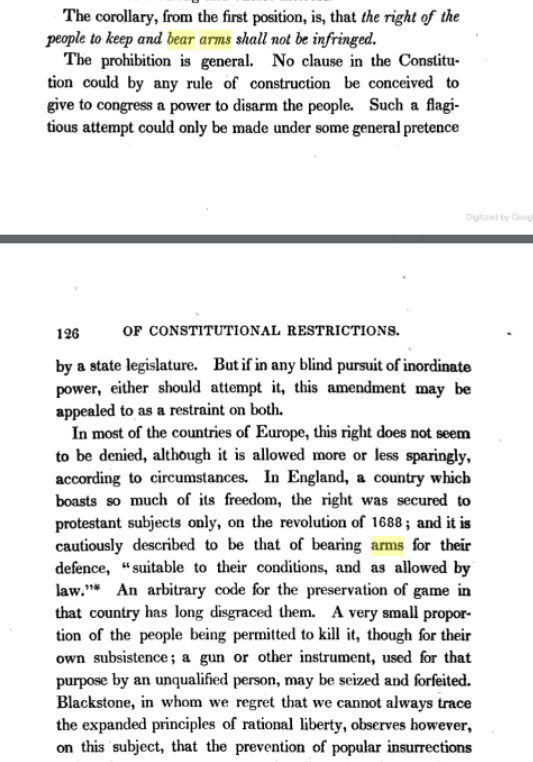
Rawle did talk about limits on carrying arms for the sake of keeping the public peace. But all he mentions for an individual is confirmation that they don’t intend to commit any crimes.

Joel Bishop, writing in 1868, says the 2A *only* protects weapons of war. In other words, Bishop would believe they can ban your brass knuckles or pocket pistols, but not your M16! google.com/books/edition/…

Robert Desty, writing in 1881. Notice how matter-of-factly a lot of these are written. They aren’t really making arguments, they are stating a plain understanding that they seem to think is obvious. google.com/books/edition/…

Senator Garret Davis, complaining about the usurpation of rights in 1864, made clear reference to a citizen’s right to bear arms along the other rights listed in the Bill of Rights. (apologies, can’t find the link for this one)

Henry Campbell Black, the original author of Black’s Law Dictionary, wrote that the Second Amendment protected an individual right, but that it only covered weapons of war. freedomforallseasons.org/Constitutional…

Thomas Cooley in 1898. Cooley was one of the most influential legal minds of his time, and served as Chief Justice of the Supreme Court of the State of Michigan from 1864 to 1885. books.google.com/books?id=VDoet…

This is from the Slavery Question speech of Rep. Edward Wade, of Ohio, in the House of Representatives, August 2, 1856. digitalcommons.cedarville.edu/pamphlet_colle…

This bit of history from the debates around adoption of the 14th amendment is fascinating, and again supports the view that 2A was seen as an individual right. books.google.com/books?hl=en&lr…


This, from John Norton Pomeroy’s “An Introduction to the Constitutional Law of the United States” (1888) shows how the objective of securing a well-armed militia is hardly mutually exclusive with an individual right. Instead, it is wholly dependent on it. google.com/books/edition/…

The Yale Law Journal in 1900, in an article entitled “Webster on the Territories”, saw the Second Amendment as protecting an individual right, albeit only protecting against federal infringement. (which was accurate til incorporation) google.com/books/edition/…
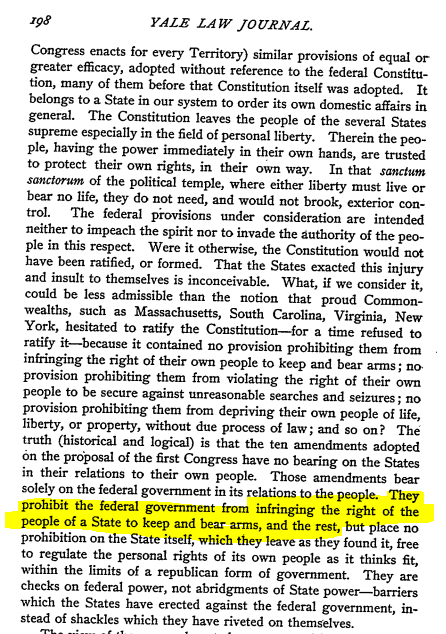
This is by Adam Seybert, M.D., in 1818. i.e. literally when several founding fathers were still alive. Hard to be much more clear than this. The title is too long to copy so I’ve included a screenshot of the title page here. google.com/books/edition/…


Benjamin Vaughan Abbott’s “Dictionary of Terms and Phrases Used in American Or English Jurisprudence”, 1879. It notes that the dispute in the caselaw was about what arms are included. No mention of lack of an individual right. google.com/books/edition/…

Joel Tiffany’s “Treatise on the Unconstitutionality of American Slavery” (1850) google.com/books/edition/…


Lysander Spooner, “The Unconstitutionality of Slavery”, 1856. google.com/books/edition/…

David Shephard Garland, James Cockcroft, Lucius Polk McGehee. “The American and English Encyclopaedia of Law” (1897) google.com/books/edition/…

Excerpts from a speech of Representative Clement Laird Vallandigham opposing a civil war-era prohibition on he sale of arms, powder, lead, and percussion caps. (1863)

This one is a bit hard to read, best screenshot I could get. It’s from 1865, published in the Congressional Globe. It’s hard to make out exactly who is speaking but I believe it is another from Senator Garrett Davis of Kentucky.

Manual of the Constitution of the United States, by Timothy Farrar. 1872. Lists “the right to keep and bear arms” among the “many natural and civil common-law rights” that are “expressly reserved” by the people. google.com/books/edition/…


“The Constitution of the United States Defined and Carefully Annotated”, by George Washington Paschal. 1868. He is citing from Cockrum v. State (1859), a case from the Supreme Court of Texas. google.com/books/edition/…

Always so interesting how even the seemingly pro-restrictions writers still were like “but lets not go too crazy, because there is an individual right to bear arms”. This one is from Charles Humphreys in 1822. Title page included because it’s too long. google.com/books/edition/…


St. George Tucker, who wrote an American version of Blackstone’s Commentaries on the Laws of England, the first of its kind and a valuable reference work for many American lawyers and law students of the time. google.com/books/edition/…


From an 1855 book by Furman Sheppard called “The Constitutional Text-book: A Practical and Familiar Exposition of the Constitution of the United States, and of Portions of the Public and Administrative Law of the…..” (Title is too long) google.com/books/edition/…

The idea that the amendment exists to defend against tyranny is often derided as the “insurrectionist” theory of the 2A and considered unserious by modern academics. But so many of the 19th century texts embrace it. Henry Flanders, 1860. google.com/books/edition/…

Similar idea here. From Joseph Bartlett Burleigh in 1852. google.com/books/edition/…


Charles Sumner in 1856. From “The Kansas Question: Senator Sumner’s Speech, Reviewing the Action of the Federal Administration Upon the Subject of Slavery in Kansas” google.com/books/edition/…

Horace Greeley’s Speech in Richmond. Several major abolitionists very clearly read the 2A as protecting an individual right. Greeley even felt that it applied to the states, before the 14th Amendment existed. google.com/books/edition/…

Add Anna Laurens Dawes, writing in 1885, among those who wasn’t a fan of concealed carry but did consider 2A to be an individual right that guards against tyranny. google.com/books/edition/…

From “Our Government Brief Talks to the American Youth on Our Governments, General and Local” (1900). By Laura Donnan. google.com/books/edition/…

“Constitutional Law, Federal and State Being a Clear and Complete Analysis of the Constitution, Together with a Summary of the Leading Decisions and Basic Principles which Go to Make Up the Fundamental Law of the State and Nation” – By Charles Chadman-1899 google.com/books/edition/…
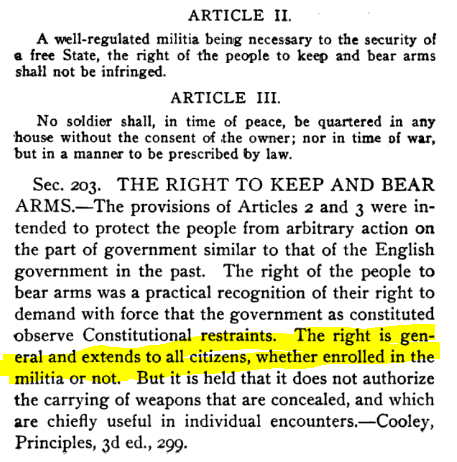
From “The Government Class Book A Youth’s Manual of Instruction in the Principles of Constitutional Government and Law” By Andrew White Young, Salter Storrs Clark · 1880 google.com/books/edition/…

A cool thread looking at how 2A was translated. twitter.com/kinney_bc/stat…
Brandon Kinney
@kinney_bc
Mar 25 22
View on Twitter
My most recent article, ““A Well-Outfitted Militia: German-American Translations of the #SecondAmendment and Original Public Meaning,” has been recommended for publication pending minor revisions.

Also notable how many times the prefatory clause was entirely omitted from summaries of the rights in the Bill of Rights. Further indication they saw this as an individual right. Two examples here, 1882 and 1873. google.com/books/edition/… google.com/books/edition/…


2A History
@2aHistory
Oct 26 22
View on Twitter
An excerpt from the 1837 “Common School Assistant” in which it talks about the rights every citizen has. How odd is it that it says citizen rights, and not “militia powers”? @Kostas Moros

Dr. Hermann Von Holst’s “The Constitutional Law of the United States of America” – 1887. books.google.com/books?id=mD4vA…

From “The Constitutional Instructor For the Use of Schools” by Daniel Parker, 1848. google.com/books/edition/…

Branching a bit out of the 19th century now, “Constitutional Law – An Introductory Treatise Designed for Use in the United States Naval Academy, and in Other Schools where the Principles of the Constitution are Studied” by Horace Jewell Fenton in 1914. google.com/books/edition/…
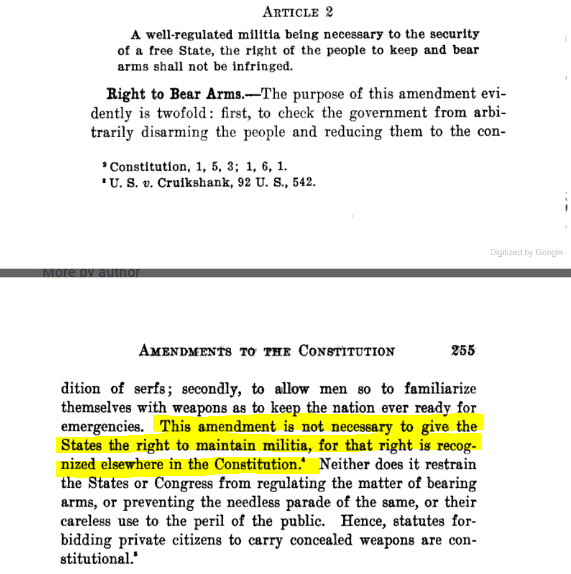
This one comes closer than others to a “collective” or “militia” right, but even it confirms that there is an individual right to some degree. “Modern American Law: Constitutional law: definitions and general principles” (1921) google.com/books/edition/…

These next three are courtesy of @2A History A Catechism Of The Constitution Of United States Of America By John W. Overall, Journalist – 1896 archive.org/details/acatec…

A Civics For Elementary Schools By John W. Davis and Charles Stewart (1905) archive.org/details/acivic…

Committee findings on the militia and public defense, New York State, Feb. 5, 1833, pg 141 archive.org/details/4thpen…

More from @2A History archive.org/details/americ…

Another from @2A History archive.org/details/acharg…

2A History
@2aHistory
Mar 02
View on Twitter
A good day for another 19th century 2A citation. This one equates the individual right to keep & bear arms to the individual right of trial by jury. It had also been the CONSTANT POLICY since 1791 that freemen arm & equip themselves to protect the country & their liberty.
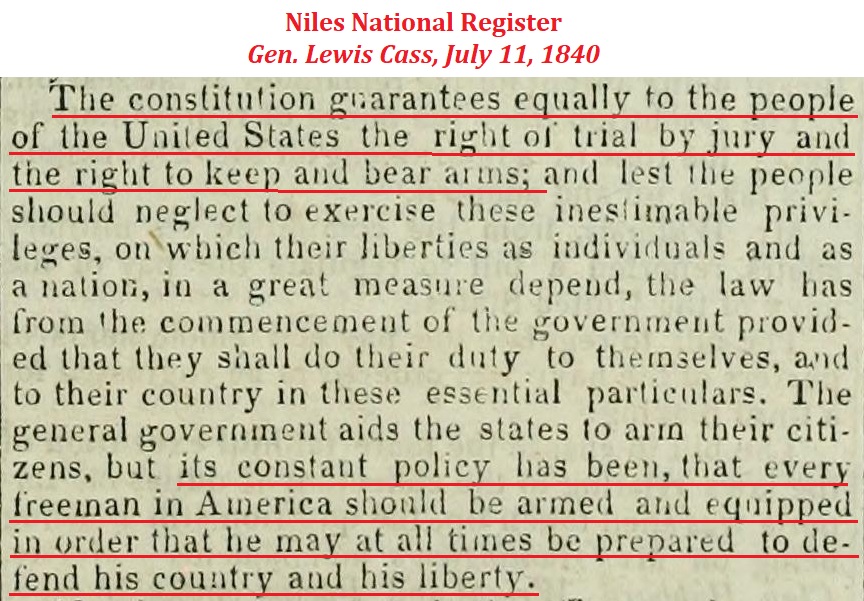
Another great find from @2A History, who deserves a lot of credit for continuing this project after I’ve had to move on to other commitments with my now more limited time (a baby will do that haha) archive.org/details/sim_am…

Another great find from @2A History The History And Topography Of The United States Of North America By John Howard Hinton – 1834 archive.org/details/histor…

New thread entry! twitter.com/BDBarney3/stat…

BarneyBD
@BDBarney3
Apr 10
View on Twitter
Here’s another one for you that I ran across on Reddit (if you didn’t already have it) reddit.com/comments/12grx…

reddit.com/comments/12grx…
r/2ALiberals on Reddit: I found a book in an archive, written in 1865. I thought it would be…

Kostas Moros
@MorosKostas
Attorney with Michel & Associates representing @crpanews. Any opinions here are only my own.
